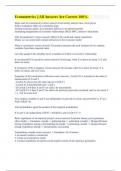Econometrics || All Answers Are Correct 100%.
Major uses of econometrics correct answers Forecasting: interest rates, stock prices
Policy evaluation: effect of a minimum wage
Testing economic policy: do consumers behave as our theories predict
Estimating (magnitudes of) economic relationships (PED, MPC, returns to education)
Why Econometrics? correct answers Observe the world and cannot experiment
Means we can rarely hold constant all factors in the economic model
What is covariance? correct answers Covariance measures the total variation of two random
variables from their expected value.
Can only gauge if the variables move in tandem or if there is an inverse relationship
If covariance(XY) is positive correct answers On average, when X is above its mean, Y is also
above its mean.
If covariance (XY) is negative correct answers On average, when X is above its mean, Y is
below its mean, and vice versa.
Properties of the correlation coefficient correct answers - Corr(X,Y) is invariant to the units of
measurement of X and Y
- Corr(X,Y) always has the same sign as Cov(X,Y)
- Corr(X,Y) is bounded between -1 and 1
- If Corr(X,Y)=0 then X and Y are said to be uncorrelated
- If Corr(X,Y)=1 then X and Y are said to be perfectly positively correlated, and we can write Y
= a + bX for some b>0
Two random variables X and Y are independent if and only if correct answers Pr(X=x, Y=y) =
Pr(X=x)Pr(Y=y)
Joint probabilities equal the product of the marginal probabilities
If X and Y are independent, E[XY] = E(X)E(Y), and Cov(X,Y) = 0
Basic ingredients of an empirical project correct answers Economic theory, past experience,
other studies -> formulate a model -> gathering data -> estimating a model -> Misspecification
testing, hypotheses testing, reformulating the model -> estimating a model -> misspecification
testing, hypotheses testing -> interpretation, forecasting
Formulating a model correct answers 1. Formulate a Q of interest
2. Economic model is constructed
3. Create an econometric model
4. Various hypotheses of interest can be stated in terms of the unknown parameters
, 5. After data on the relevant variables have been collected, econometric models are used to
estimate the parameters in the econometric model and to formally test hypotheses of interest
Goals of econometric analysis correct answers To estimate the parameters in the model and to
test hypotheses about these parameters; the values and signs of the parameters determine the
validity of an economic theory and the effect of certain policies
Cross-sectional data correct answers Consists of a sample of individuals, households, firms,
cities, states, countries, or a variety of other units, taken at a given point in time. Sometimes, the
data on all units do not correspond to precisely the same time period.
Time-series data correct answers Consists of observations on a variable or several variables over
time. Examples of time series data include stock prices, money supply, consumer prices index,
gross domestic product, annual murder rates and automobile sales figure.
Pooled Cross Sections correct answers Repeated independent cross sections over time
Panel or Longitudinal data correct answers Consists of a time series for each cross-sectional
member in the data set. E.g. wage, education and employment history for a set of individuals
followed over a ten-year period.
The disturbance (error) term correct answers It accounts for all the factors that affect y that we
have not explicitly accounted for in our regression function.
Two key assumptions about the disturbance (error) term correct answers On average, the
disturbance term is zero.
- E(u)=0
- Although the combined effect of the unobservable factors is sometimes positive, it can also be
negative.
- If an intercept (Bo) is included, E(u) is always normalised to 0.
The disturbances are unrelated to the explanatory variable (crucial!).
- More specifically, the average value of u does not depend on the value of x.
- Need to ensure that knowing something about x does not give us any information about u, so
that they are completely unrelated.
- E(u|x) = E(u)
- Average value of the unobservables is the same irrespective of x.
Combining these assumptions means E(u|x)=0 (Zero conditional mean assumption)
Why is the zero conditional mean assumption important? correct answers - If E(u|x)=0 is valid
then E(y|x)=B0+B1x
- E(y|x)=B0+B1x shows that the population regression function, E(y|x), is a linear function of x.
- The linearity means that an one-unit increase in x changes the expected value of y by the
amount B1.
- For any given value of x the distribution of y is centered about E(y|x).




